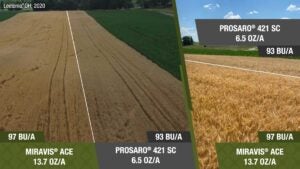The fungicide’s ADEPIDYN technology helps wheat plants conserve water and remain healthier for longer.
Low-moisture seasons can make wheat growers complacent about applying a fungicide to their crop. Troublesome pathogens such as Fusarium are driven by consistent moisture, such as frequent rains or heavy dews, so does that mean skipping a fungicide during drier years is acceptable?
Over the past three growing seasons, at least part of the Midwest has been in a drought. In this situation, while the threat from fungi may be reduced, wheat and other small-grain plants face other health hazards. Without adequate moisture, they will shut themselves down early in an effort to complete their life cycle, which leads to a reduced kernel weight and a shorter grain filling period in the tillers.
This forces many growers to either proceed with a meager harvest or choose to abandon a crop altogether. Both scenarios lead to significant financial loss.
It doesn’t have to be that way.
Gone are the days when a fungicide application has strictly curative properties. Innovative products such as Syngenta’s Miravis® Ace can both protect against several diseases in cereal crops and deliver quantifiable yield-boosting plant-health benefits. With the inclusion of ADEPIDYN® technology, Miravis Ace lowers the leaf transpiration rate in plants to make them more tolerant of drought, yet it does so without negatively affecting the photosynthetic properties of the plant.
“As we keep a plant greener, longer and make it more efficient, we will add yield consistently, whether it be in a dry season or if we get into that wet season where, all of a sudden, diseases are more prevalent,” said Dean Grossnickle, Technical Development Lead for the West Heartland Commercial Unit at Syngenta. “That’s why it’s a good rule of thumb or good practice to make Miravis Ace a standard in your program.”
Stress reactions during a drought force wheat to become less efficient with both water and nutrients, which can lead to cell destruction in the plant. And once those cells are lost, there’s no gaining them back, which puts a premium on nurturing the plant through such a tough environment.

The ADEPIDYN technology in Miravis Ace helps wheat plants conserve water — cells become more efficient, don’t give up resources as readily, and remain healthier for longer. Those benefits position the plants better for harvest.
“If we can keep that cell intact through these stressful times, which Miravis Ace and the ADEPIDYN component help us to do, it makes that whole system more efficient and sustainable,” said Grossnickle, who has been at Syngenta for more than 11 years. “Keeping yourself green through that fill period, instead of letting drought really take its toll, translates to much better yields.”
Even when it’s unclear what kind of weather patterns a season will bring and what disease conditions will be in place, trial data has shown that using Miravis Ace leads to an 8.25 bu/A1 yield increase over untreated wheat, and Tyler Harp, Syngenta Technical Product Lead for Row Crop Fungicides, said that it often amounts to a five to six bu/A increase over competing fungicidal products2.
“You don’t know when it’s going to be a bad year, so you really need to make the application even before that’s confirmed,” Harp said.
Grossnickle added, “The environment changes constantly for American growers. A lot of times, we might be in some of those stressful conditions, where drought comes into play, and I like to focus on the plant-health benefits of Miravis Ace. But if we have more moderate temperatures, and we have lots of rain events, which are very good for highly productive wheat, then we have more likelihood to see Fusarium head blight, and we have to worry about that and other diseases, like rust or Septoria.”
In addition to their mix of preventative, curative, and plant-health features, Miravis Ace and its ADEPIDYN technology also deliver a more generous application window than competitor fungicides.
Wheat is most susceptible to pathogens at early flowering when the anthers form. It’s why growers long relied heavily on older triazole-only fungicides, which targeted the narrow 10.51 to 10.52 stage on the Feekes scale and were most successful if they were able to cover the entire wheat head with the product.
The application window for Miravis Ace, on the other hand, is much broader. The ADEPIDYN technology is labeled to be applied from 10.3, when the head is halfway emerged from the sheath, to 10.52, when the head is fully emerged and in full flower.
“I did not see any disease issues in my fields from the combine vantage point,” said Thomas Abel, a grower in Illiopolis, Illinois, who uses Miravis Ace. “Even in a drought year, grain quality was good.”
This is a complete strategy shift from even a decade ago, because back then, the timing window was so critical and plant-health benefits from market fungicides were negligible compared to what Miravis Ace is able to achieve today.

And with growers being bombarded by so much messaging — for example, about their machinery, fertilizer, seed, and crop protection options — Grossnickle explains that getting them to embrace the step change that the ADEPIDYN technology brings to their fields can be difficult. But he said that once wheat producers see the effects in their farms and experience the effectiveness of the fungicide on plant health and yield, even in a drought season, they then understand how their investment pays off.
It keeps them coming back to the Miravis Ace application year after year.
“I have been putting Miravis Ace on 100 percent of all wheat acres the last few years, and I have had great results. I wouldn’t go without using them,” said grower Eldon Sell of Ohio. “The plant-health benefits are so important, even in a dry year.”
That comes back to being able to reduce water loss while maintaining a high rate of photosynthesis. It’s staying greener in the field, for longer.
“Maybe the season will be a high disease year, maybe it’s a tough year in a drought,” Grossnickle said, “but if you make Miravis Ace part of your plan and stick to the plan, you’re going to preserve more yield in the long run.”
This article was published on behalf of Syngenta. Visit this page to find a Syngenta Crop Protection Specialist near you.
Ryan Tipps is the founder and managing editor of AGDAILY. He has covered farming since 2011, and his writing has been honored by state- and national-level agricultural organizations.



